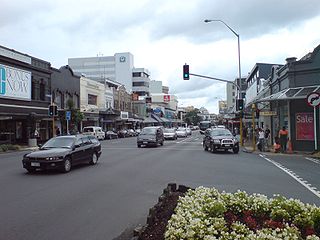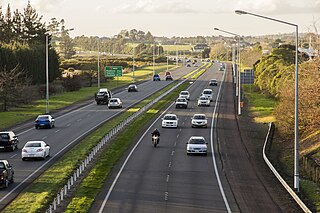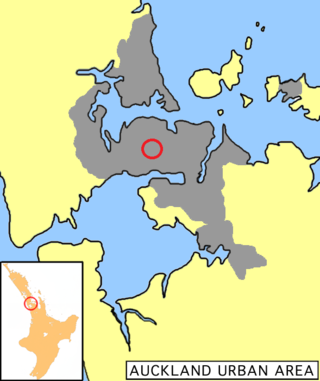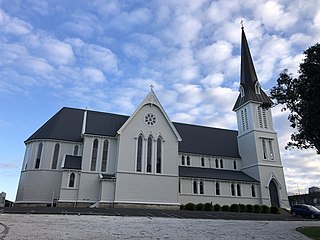
Newmarket is an Auckland suburb to the south-east of the central business district. With its high building density, especially of retail shops, it is considered New Zealand's premier retailing area, and a rival of local competitor Auckland CBD.
Captain William Cornwallis Symonds was a British Army officer who was prominent in the early colonisation of New Zealand.

Karangahape Road is one of the main streets in the central business district (CBD) of Auckland, New Zealand. The massive expansion of motorways through the nearby inner city area – and subsequent flight of residents and retail into the suburbs from the 1960s onwards – turned it from one of Auckland's premier shopping streets into a marginal area with the reputation of a red light district. Now considered to be one of the cultural centres of Auckland, since the 1980s–1990s it has been undergoing a slow process of gentrification, and is now known for off-beat cafes and boutique shops.

Boston Road railway station was a station on the Western Line of the Auckland rail network, near St Peter's College and Auckland Grammar School. It was beneath an overbridge of State Highway 1, one of the busiest motorways in New Zealand. At the southern end of the station is the north western wall of Mt Eden Prison. The station closed on 10 April 2010, the day after the opening of the new Grafton station, and has since been largely demolished.

Belmont is a suburb of Auckland, New Zealand, located on the North Shore. The suburb is in the North Shore ward, one of the thirteen administrative divisions of Auckland Council.

Eden Terrace is an inner city suburb of Auckland, located 2 km south of the Auckland CBD, in the North Island of New Zealand. Eden Terrace is one of Auckland's oldest suburbs, and also one of the smallest; at just 47 hectares only Newton is smaller.

Newton is a small suburb of Auckland, New Zealand, under the local governance of the Auckland Council. It had a population of 1,641 in the 2013 census.

St Peter's College is a Catholic secondary school for boys in the Edmund Rice tradition, and dedicated to St Peter. It is located in the central Auckland area of Grafton, Auckland, New Zealand. With a roll of over 1300, the school is one of the largest Catholic schools in New Zealand. St Peter's College was established in 1939 as a successor of Auckland's earliest school and of St Peter's School, founded in 1857. However, Auckland also had another Catholic secondary school dedicated to St Peter, Hato Petera College or St Peter's Māori College, which existed for 90 years from 1928 until 2018 in Northcote.

The Central Connector, is a bus route between Britomart Transport Centre in the Auckland CBD, New Zealand, and the commercial suburb of Newmarket. It has some aspects of a bus rapid transit link. It was expected to improve journey times by about 14 minutes for around 2,600 buses per week, about 65,000 passengers daily. Work began in April 2008 and is now finished.

The Auckland Southern Motorway is the major route south out of the Auckland Region of New Zealand. It is part of State Highway 1.

St Paul's Church is an historic Anglican church, located on Symonds Street near the University of Auckland and Auckland University of Technology, in the central business district of Auckland, New Zealand. The church is the longest established parish in the city and has one of the largest Anglican congregations in Australasia.

Grafton railway station is a station serving the inner-city suburb of Grafton in Auckland, New Zealand. It is located on the Western Line of Auckland's passenger rail network and consists of an island platform located in a trench near the intersection of Khyber Pass Road and Park Road. The station opened on 11 April 2010.
E. Mahoney and Son was an architectural business consisting of Edward Mahoney and his son and architectural partner, Thomas Mahoney (1855–1923), who were prominent New Zealand architects based in Auckland. They were able exponents of Gothic Revival and other styles, especially built in wood, but also in masonry and concrete. They designed numerous public (especially churches, notable examples of which are Our Lady of the Assumption Catholic Church, Onehunga, Church of St John the Baptist, Parnell, St Patrick's Cathedral, Auckland and the Church of the Holy Sepulchre, Khyber Pass Road and private buildings, many of which are still standing. They made a considerable contribution to Auckland's architectural heritage.

Symonds Street is a street in Auckland, New Zealand's most populous city. The road runs southwest and uphill from the top of Anzac Avenue, through the City Campus of University of Auckland, over the Northwestern Motorway and Auckland Southern Motorway and to the start of New North Road and Mount Eden Road.

Symonds Street Cemetery is a historic cemetery and park in central Auckland, New Zealand. It is in 5.8 hectares of deciduous forest on the western slope of Grafton Gully, by the corner of Symonds Street and Karangahape Road, and is crossed by the Grafton Bridge. The street is named for William Cornwallis Symonds, a British Army officer prominent in the early colonisation of New Zealand. It has a Historic Place – Category I listing with the New Zealand Historic Places Trust. Maintenance and administration of the cemetery is provided by the Auckland Council.

Eden Valley is an inner-city suburb of Auckland, the largest and most populous urban area in New Zealand. The suburb grew around Dominion Road, one of the Auckland's main arterial routes. Eden Valley's commercial hub is made up of a collection of businesses, shops, and dining options that service the area. The eclectic collection of shop fronts and signage on Dominion Road has aptly been described as, "colour and chaos". The "colour and chaos" of the commercial hub is strongly contrasted by the surrounding residential area. Eden Valley is characterized by heritage buildings that house modern day businesses, a residential area that has a range of late Victorian, Edwardian and transitional bay villas, and basalt and scoria stone walls that give the area a long established feel.
This is a timeline of the history of the city of Auckland in New Zealand.

William Henry Skinner (1838–1915) was a Welsh-born architect who migrated to New Zealand.

The Church of the Holy Sepulchre, commonly known as Holy Sep and St Sepulchre's, is an historic Anglican church located on Khyber Pass Road, Grafton, near the central business district of Auckland, New Zealand. The church and wider marae complex are also known as.

Captain George Augustus Bennett was an English military engineer of the Corps of Royal Engineers, Board of Ordnance. He served in Corfu (1828–1832), on the Ordnance Survey of Ireland (1832–1841), as Commanding Royal Engineer in New Zealand (1842–1845) and first president of the Auckland Mechanics' Institute (1842–1845). Whilst serving in Ireland he devised and implemented the system of contours for Ordnance Survey maps. In the Colony of New Zealand he designed the flagstaff blockhouse central to the Battle of Kororāreka (1845) and other military works.

























